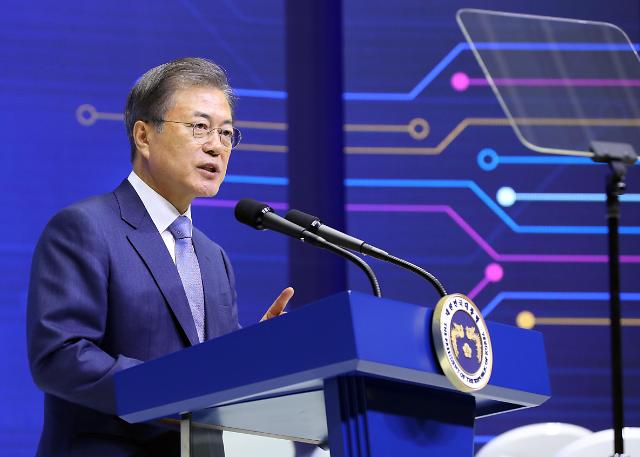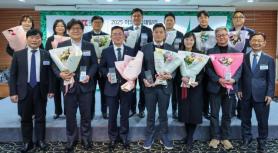
[Yonhap Photo]
"Our goal is clear," President Moon Jae-in declared in his speech at Samsung Electronics' plant in Hwaseong, about 45 kilometers (28 miles) southwest of Seoul, promising to provide all-out government support for the growth of South Korea's semiconductor industry.
"While maintaining our top position in the memory semiconductor field, we should leap to a comprehensive semiconductor powerhouse by achieving the world's top position in system semiconductor foundry and a 10 percent market share in the fabless field by 2030," Moon said, citing "an endless possibility of growth" in the system semiconductor field.
Fabless manufacturing is the design and sale of hardware devices and semiconductor chips while outsourcing the fabrication of devices to a specialized manufacturer called a semiconductor foundry. South Korea's current market share in global fabless manufacturing stands at 1.6 percent.
Moon's speech came six days after Samsung revealed a massive investment worth 133 trillion won ($113.8 billion) by 2030 to strengthen its competitiveness in System LSI and foundry businesses, saying it aims to become the world leader in not only memory semiconductors but also logic chips.
LSI, also known as Large-Scale-Integration, is a chip-making process in which thousands of transistors are integrated or embedded onto a single silicon chip. Foundry refers to a semiconductor fabrication plant operation. The world's largest microchip maker said its investment in R&D and facilities for logic semiconductors would amount to an average 11 trillion per year until 2030.
"We applaud your grand goal and the government will actively extend help," Moon said, shaking hands with Jay Y. Lee, the virtual head of South Korea's largest Samsung conglomerate, and praising his aggressive strategy. Samsung has vowed to lead the establishment of an ecosystem for South Korea's system semiconductor industry.
The Ministry of Trade, Industry and Energy came up with an investment of more than one trillion won over the next 10 years in developing next-generation semiconductor technologies and training 17,000 high-end professionals. About 100 billion won was earmarked for the creation of a fabless business fund.
The ministry called for the establishment of a cooperative platform called "Alliance 2.0" involving 25 private and public organizations in areas where there is high demand for system semiconductors or where South Korean companies can secure competitiveness within a short period of time, focusing on five major strategic areas -- automobiles, bio, energy, IoT home appliances and machinery and robots.
"If our challenge in the system semiconductor field is successful, we will establish ourselves as a comprehensive semiconductor powerhouse in name and reality," Moon said, adding the semiconductor sector accounted for 20 percent of South Korea's total exports.
Samsung's domestic rival, SK hynix, has won state approval to use land in Yongin, about 40 kilometers (25 miles) south of Seoul, and build the world's largest semiconductor cluster with an investment of about 120 trillion won after 2022. In the cluster aimed at maintaining a competitive edge over Chinese companies, SK hynix plans to build four fabrication plants and house about 50 equipment, parts and material makers.
China was a major topic at a meeting of Samsung shareholders in March last year, with top executives calling for pre-emptive measures to head off a daunting challenge by Chinese rivals and widen a gap with them by stepping up the development of new technologies and products.
Copyright ⓒ Aju Press All rights reserved.



